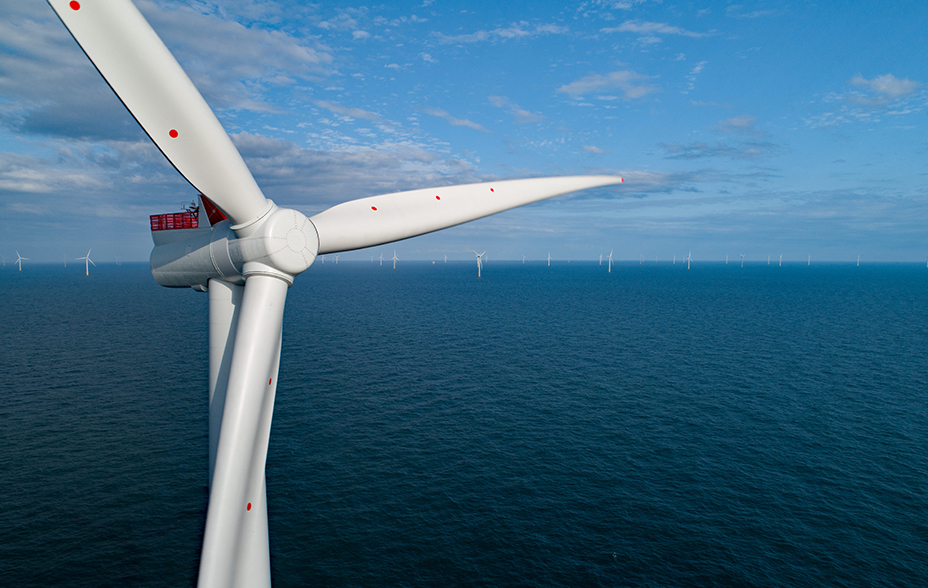
All investment strategies have the potential for profit and loss, your or your clients’ capital may be at risk.
The words ‘greenhouse gas emissions’ conjure images of melting polar ice caps, severe flooding, extreme heat waves and devastating droughts in most people’s minds. However, I recently visited a company trying to change that.
Just outside Chicago, scientists at LanzaTech are commercialising a process that converts industrial emissions into ethanol. The colourless liquid can be further refined into materials for fabrics for clothing or sustainable aviation fuel.
The chemicals specialist is helping to turn greenhouse gas emissions from waste into a valuable commodity. And its partners include ArcelorMittal, one of the world’s largest steel makers, British Airways, and Zara.
LanzaTech is just one of many companies using new technologies and innovations to solve climate change. But for now, there’s no shortage of doom-and-gloom news about the issue. And the rhetoric has led to a new trend of ‘eco-anxiety’, especially among younger people.
This can be counterproductive. While I don’t want to downplay the threats of climate change, I am also confident in human ingenuity and technological advances as drivers of progress.
As a manager for the Positive Change Strategy, I am fortunate to meet passionate entrepreneurs and business people working on innovations that can help address climate change. Positive Change invests in some of those companies and will likely make more investments in the future. The remainder of this article looks at some of those businesses and innovations.
Energy and climate
The causal link between greenhouse gas (GHG) emissions and climate change is well-established. When we examine the source of GHG emissions, the vast majority comes from our energy use (73 per cent). However, if we include the emissions from agriculture (because food is another form of energy), then emissions from energy become more than 90 per cent. Hence, decarbonising our energy system is essential to addressing climate change.
Source: Our World in Data, 2016. ourworldindata.org/emissions-by-sector
Another reason to focus on energy is its centrality to human flourishing. There is a close relationship between energy consumption and economic activity. We can debate whether GDP is a useful measure of humanity’s success, but it’s clear that a flourishing society requires a large and growing amount of energy.
A flourishing society, in the sense of more sophisticated art, science and technology and emotional connections between individuals, must form part of the vision for a sustainable future. Therefore, our goal for the energy system should focus on its decarbonisation and growth.
Source: Our World in Data, based on Vaclav Smil (2017) and BP Statistical Review of World Energy. World GDP in 2011 Int.$, based on World Bank & Maddison (2017)
How do we achieve this goal? I believe there are four things we need to do:
1. Electrify as much energy use as possible – transportation, heating and others.
2. Ensure that electricity comes from renewable sources. This involves accelerating the buildout of solar, wind and other renewables and investing in the grid to handle more intermittent generation and greater electricity demand.
3. Decarbonise hard-to-abate sectors by improving efficiency, reducing waste and developing novel technologies.
4. Scale up high-quality carbon removal projects to remove historical excess CO2.
Positive Change invests in companies that are contributing to all four areas.
1. Electrification
Electricity’s share of our energy consumption has slowly increased since the Edison Electric Light Company began operating the world’s first commercial power station at 57 Holborn Viaduct in London in 1882. In 1973, electricity accounted for 9.5 per cent of the world’s final energy consumption. By 2019, this has risen to 19.7 per cent.
The slow pace of electrification thus far is a reminder that electricity has suffered from two limitations: it’s not well-suited for applications that require energy in high-density forms, and it’s less economical for processes requiring high temperatures. Thankfully, technological advances are helping to address both limitations, providing hope that electrification will accelerate in the coming decades.
Cheaper and better batteries are helping to address the first limitation, enabling the electrification of transportation. Portfolio holding Tesla is a pioneer of electric vehicles. Since launching the original Tesla Roadster, Tesla has steadily brought down the cost of electric vehicles through innovation and scale.
The pace of cost reduction underpins Tesla’s competitive advantage and is vital to improving the affordability of electric vehicles. Tesla delivered 1.3 million electric vehicles in 2022, and its long-term ambition is to produce 20 million electric vehicles per year.
Road transportation accounts for 12 per cent of global GHG emissions. If we electrify road transportation entirely and ensure the electricity comes from renewable sources, this could avoid six billion tons of carbon dioxide equivalent (CO2e) annually, which is equivalent to the annual GHG emissions of North America.
Source: Baillie Gifford research, Tesla, trailing twelve-month data.
Electrification is taking off, literally. Portfolio holding Joby Aviation is leading the development and commercialisation of a new mode of transportation, electric vertical take-off and landing (eVOTL). Joby’s aircraft has a range of up to 150 miles and a top speed of 200 miles per hour. The company is progressing with Federal Aviation Administration (FAA) certification to certify its aircraft for commercial passenger use and has partnered with Delta, ANA, and others to realise this concept.
A range of innovations is required to address electricity’s second limitation. For instance, the Australian company Calix is developing a new type of kiln that can heat minerals to 950C using electricity. Its technology could help to decarbonise industries such as lime and cement production, which thus far relied on fossil fuels for heating. Boston Metal is working on electrifying steel production with its molten oxide electrolysis technology. The firm uses electricity to heat iron ore in a cell at 1,600C, enabling it to separate oxide from iron without needing carbon.
2. Renewable generation and the grid
While coal powered Edison’s first power station in London, today, more and more electricity generation involves renewable technologies. In 2020, 80 per cent of the world’s new electricity capacity came from renewable sources, with solar and wind accounting for 91 per cent of that. Since 2010, the share of global electricity generation from solar and wind has quintupled from 2 per cent to 10 per cent. In the UK, solar and wind have gone from 3 per cent of electricity generation to 25 per cent over the same period.
Portfolio holding Ørsted is contributing to the buildout of renewable generation. The company is the world leader in offshore wind after pioneering the sector in the early 21st century. It’s also a major developer of onshore wind and solar projects, and invests in newer technologies such as green hydrogen. In 2022, Ørsted generated 30 tera-watt hours (TWh) of electricity from solar and wind, helping to avoid 18.2 million tons of CO2e or equivalent to the total annual emissions of 4.5 million cars.

© Ørsted
As more solar and wind join the generation mix, we need to invest more in our electricity grids to overcome the challenge of intermittency. Energy storage will play an important role. Energy storage stores excess electricity and helps maintain grid stability through frequency management and synthetic inertia.
Portfolio holdings Tesla and Northvolt are two companies contributing to this area. Tesla is a leading provider of stationary energy storage systems and software, with an annual deployment of 6.5 gigawatt hours (GWh) in 2022. Northvolt is building out Europe’s battery production capacity, with an emphasis on sustainability through using renewable power and recycling.
3. Hard-to-abate sectors
Agriculture accounts for about 20 to 25 per cent of global GHG emissions. Decarbonising food production is a complex challenge that requires multiple solutions.
Portfolio holding Deere is contributing to this goal with its precision agriculture offerings. Precision agriculture leverages advancements in digital technologies to help farmers obtain higher yields while reducing pesticide and fertiliser usage. For example, Deere’s See & Spray technology uses computer vision and machine learning to identify weeds from crops in real time. Sprayers then target only the weeds, reducing herbicide usage by over two-thirds.
Construction is another tricky sector to decarbonise. Buildings account for 38 per cent of energy- and process-related GHG emissions globally. The industry is one of the slowest to digitalise. As a result, a significant proportion of projects finish late, and 10 per cent of the materials used in construction go to waste.
Portfolio holding Autodesk is changing this. The company is the leading software provider for the architecture, engineering, and construction (AEC) sector. In recent years, it has launched a range of products that are helping to improve efficiency.
For instance, Autodesk’s Embodied Carbon Calculator helps designers choose materials with lower embodied carbon. Autodesk Insight empowers architects and engineers to design more energy-efficient buildings by providing an advanced simulation of building performance. And Autodesk Construction Cloud optimises workflows for project owners and contractors to reduce the likelihood of rework.
4. Carbon removal
To maximise our chances of limiting global warming to 1.5C, the world must reduce emissions at an unprecedented speed and, in addition, remove historical and unavoidable CO2 emissions from the atmosphere. While nature-based solutions such as soil management and reforestation will play a role, there is increasing consensus that engineered solutions will complement nature-based solutions by providing high permanence and verifiable carbon removal.
Climeworks is a leader in direct air capture (DAC). Two mechanical engineering students from ETH Zurich founded the company in 2009, aiming to inspire one billion people to remove CO2 from the air. In 2021, the company launched Orca, the world’s largest operating DAC and storage facility, in Iceland. It partnered with companies including Microsoft, BCG, UBS and Swiss Re.

© Image courtesy of Climeworks. Climeworks' Orca carbon capture plant in Iceland.
In 2022, along with other investors, Baillie Gifford supported Climeworks’ CHF 600m equity raise (£534m at 1 April 2023), providing primary capital to support the company’s expansion. Climeworks is now constructing its next facility, Mammoth, which, when operational, will have an annual nominal capture capacity of up to 36,000 tons. Climeworks will not stop there. The company has an ambitious scale-up plan to capture 1 million tons of CO2 from the atmosphere by 2030, and to be on track to gigaton capacity by 2050.
Summary
Climate change is an urgent challenge that society needs to address. The task might appear daunting, but there are reasons for optimism. Technological advancements and human ingenuity will usher in solutions we can’t imagine today.
As managers of Positive Change, we will be searching for them. We will deepen our research in this area, identifying promising innovations and finding opportunities worth our shareholders’ investment. We believe that companies addressing climate change have the prospects of creating enormous societal and economic value over the coming decades.
Risk Factors
The views expressed should not be considered as advice or a recommendation to buy, sell or hold a particular investment. They reflect opinion and should not be taken as statements of fact nor should any reliance be placed on them when making investment decisions.
This communication was produced and approved in May 2023 and has not been updated subsequently. It represents views held at the time of writing and may not reflect current thinking.
Potential for Profit and Loss
All investment strategies have the potential for profit and loss, your or your clients’ capital may be at risk. Past performance is not a guide to future returns.
This communication contains information on investments which does not constitute independent research. Accordingly, it is not subject to the protections afforded to independent research, but is classified as advertising under Art 68 of the Financial Services Act (‘FinSA’) and Baillie Gifford and its staff may have dealt in the investments concerned.
All information is sourced from Baillie Gifford & Co and is current unless otherwise stated.
The images used in this communication are for illustrative purposes only.
Important Information
Baillie Gifford & Co and Baillie Gifford & Co Limited are authorised and regulated by the Financial Conduct Authority (FCA). Baillie Gifford & Co Limited is an Authorised Corporate Director of OEICs.
Baillie Gifford Overseas Limited provides investment management and advisory services to non-UK Professional/Institutional clients only. Baillie Gifford Overseas Limited is wholly owned by Baillie Gifford & Co. Baillie Gifford & Co and Baillie Gifford Overseas Limited are authorised and regulated by the FCA in the UK.
Persons resident or domiciled outside the UK should consult with their professional advisers as to whether they require any governmental or other consents in order to enable them to invest, and with their tax advisers for advice relevant to their own particular circumstances.
Financial Intermediaries
This communication is suitable for use of financial intermediaries. Financial intermediaries are solely responsible for any further distribution and Baillie Gifford takes no responsibility for the reliance on this document by any other person who did not receive this document directly from Baillie Gifford.
Europe
Baillie Gifford Investment Management (Europe) Limited provides investment management and advisory services to European (excluding UK) clients. It was incorporated in Ireland in May 2018. Baillie Gifford Investment Management (Europe) Limited is authorised by the Central Bank of Ireland as an AIFM under the AIFM Regulations and as a UCITS management company under the UCITS Regulation. Baillie Gifford Investment Management (Europe) Limited is also authorised in accordance with Regulation 7 of the AIFM Regulations, to provide management of portfolios of investments, including Individual Portfolio Management (‘IPM’) and Non-Core Services. Baillie Gifford Investment Management (Europe) Limited has been appointed as UCITS management company to the following UCITS umbrella company; Baillie Gifford Worldwide Funds plc. Through passporting it has established Baillie Gifford Investment Management (Europe) Limited (Frankfurt Branch) to market its investment management and advisory services and distribute Baillie Gifford Worldwide Funds plc in Germany. Similarly, it has established Baillie Gifford Investment Management (Europe) Limited (Amsterdam Branch) to market its investment management and advisory services and distribute Baillie Gifford Worldwide Funds plc in The Netherlands. Baillie Gifford Investment Management (Europe) Limited also has a representative office in Zurich, Switzerland pursuant to Art. 58 of the Federal Act on Financial Institutions (“FinIA”). The representative office is authorised by the Swiss Financial Market Supervisory Authority (FINMA). The representative office does not constitute a branch and therefore does not have authority to commit Baillie Gifford Investment Management (Europe) Limited. Baillie Gifford Investment Management (Europe) Limited is a wholly owned subsidiary of Baillie Gifford Overseas Limited, which is wholly owned by Baillie Gifford & Co. Baillie Gifford Overseas Limited and Baillie Gifford & Co are authorised and regulated in the UK by the Financial Conduct Authority.
Hong Kong
Baillie Gifford Asia (Hong Kong) Limited 柏基亞洲(香港)有限公司 is wholly owned by Baillie Gifford Overseas Limited and holds a Type 1 and a Type 2 license from the Securities & Futures Commission of Hong Kong to market and distribute Baillie Gifford’s range of collective investment schemes to professional investors in Hong Kong. Baillie Gifford Asia (Hong Kong) Limited 柏基亞洲(香港)有限公司 can be contacted at Suites 2713-2715, Two International Finance Centre, 8 Finance Street, Central, Hong Kong. Telephone +852 3756 5700.
South Korea
Baillie Gifford Overseas Limited is licensed with the Financial Services Commission in South Korea as a cross border Discretionary Investment Manager and Non-discretionary Investment Adviser.
Japan
Mitsubishi UFJ Baillie Gifford Asset Management Limited (‘MUBGAM’) is a joint venture company between Mitsubishi UFJ Trust & Banking Corporation and Baillie Gifford Overseas Limited. MUBGAM is authorised and regulated by the Financial Conduct Authority.
Australia
Baillie Gifford Overseas Limited (ARBN 118 567 178) is registered as a foreign company under the Corporations Act 2001 (Cth) and holds Foreign Australian Financial Services Licence No 528911. This material is provided to you on the basis that you are a “wholesale client” within the meaning of section 761G of the Corporations Act 2001 (Cth) (“Corporations Act”). Please advise Baillie Gifford Overseas Limited immediately if you are not a wholesale client. In no circumstances may this material be made available to a “retail client” within the meaning of section 761G of the Corporations Act.
This material contains general information only. It does not take into account any person’s objectives, financial situation or needs.
South Africa
Baillie Gifford Overseas Limited is registered as a Foreign Financial Services Provider with the Financial Sector Conduct Authority in South Africa.
North America
Baillie Gifford International LLC is wholly owned by Baillie Gifford Overseas Limited; it was formed in Delaware in 2005 and is registered with the SEC. It is the legal entity through which Baillie Gifford Overseas Limited provides client service and marketing functions in North America. Baillie Gifford Overseas Limited is registered with the SEC in the United States of America.
The Manager is not resident in Canada, its head office and principal place of business is in Edinburgh, Scotland. Baillie Gifford Overseas Limited is regulated in Canada as a portfolio manager and exempt market dealer with the Ontario Securities Commission ('OSC'). Its portfolio manager licence is currently passported into Alberta, Quebec, Saskatchewan, Manitoba and Newfoundland & Labrador whereas the exempt market dealer licence is passported across all Canadian provinces and territories. Baillie Gifford International LLC is regulated by the OSC as an exempt market and its licence is passported across all Canadian provinces and territories. Baillie Gifford Investment Management (Europe) Limited (‘BGE’) relies on the International Investment Fund Manager Exemption in the provinces of Ontario and Quebec.
Israel
Baillie Gifford Overseas is not licensed under Israel’s Regulation of Investment Advising, Investment Marketing and Portfolio Management Law, 5755-1995 (the Advice Law) and does not carry insurance pursuant to the Advice Law. This material is only intended for those categories of Israeli residents who are qualified clients listed on the First Addendum to the Advice Law.
Ref: 44674 10020617





